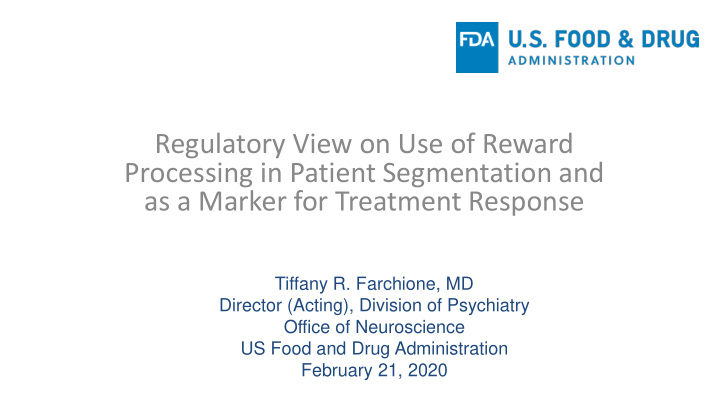



Regulatory View on Use of Reward Processing in Patient Segmentation and as a Marker for Treatment Response Tiffany R. Farchione, MD Director (Acting), Division of Psychiatry Office of Neuroscience US Food and Drug Administration February 21, 2020
Reward Processing Tasks in Clinical Trials • Potential probe for apathy, anhedonia, or negative symptoms • More closely linked to pathophysiology • Clinical relevance • Can reward processing task ever be a primary endpoint? www.fda.gov 2
Anhedonia, Apathy, Negative Symptoms • As clinical constructs, these are qualitatively different • How similar is the underlying circuitry? www.fda.gov 3
Understanding Pathophysiology • Goal: Move from subjective/descriptive constructs to pathophysiology – “Activation” (e.g., BOLD signal) is a gross phenomenon – Underlying cascade of events not characterized – But, closer to pathophysiology than rating scales www.fda.gov 4
Clinical Relevance? • Current assessments based on rating scales • Imaging measures are putative biomarkers – A biomarker is a defined characteristic that is measured as an indicator of normal biological processes, pathogenic processes, or responses to an exposure or intervention, including therapeutic interventions. Molecular, histologic, radiographic, or physiologic characteristics are types of biomarkers. A biomarker is not an assessment of how an individual feels, functions, or survives. www.fda.gov 5
Reward Processing as Primary Endpoint? • “…once a link between changes in performance on these tasks and changes in clinical outcomes has been established…” www.fda.gov 6
Biomarker Qualification • Multistep process with lots of feedback and interaction along the way – Letter of Intent – Qualification Plan – Full Qualification Package www.fda.gov 7
Qualification Process www.fda.gov * https://www.fda.gov/drugs/cder-biomarker-qualification-program/about-biomarkers-and-qualification 8
Letter of Intent • The LOI provides initial information about the biomarker proposal including: – Drug development need the biomarker is intended to address – Biomarker information – Context of Use (COU) – Information on how the biomarker will be measured www.fda.gov 9
Context of Use • [BEST biomarker category] that [action] [purpose of intervention] of [target populations] in [type of study]. • Types of biomarkers: – Diagnostic ─ Reasonably likely surrogate – Monitoring ─ Safety – PD/Response ─ Susceptibility/Risk – Prognostic www.fda.gov 10
Recommend
More recommend